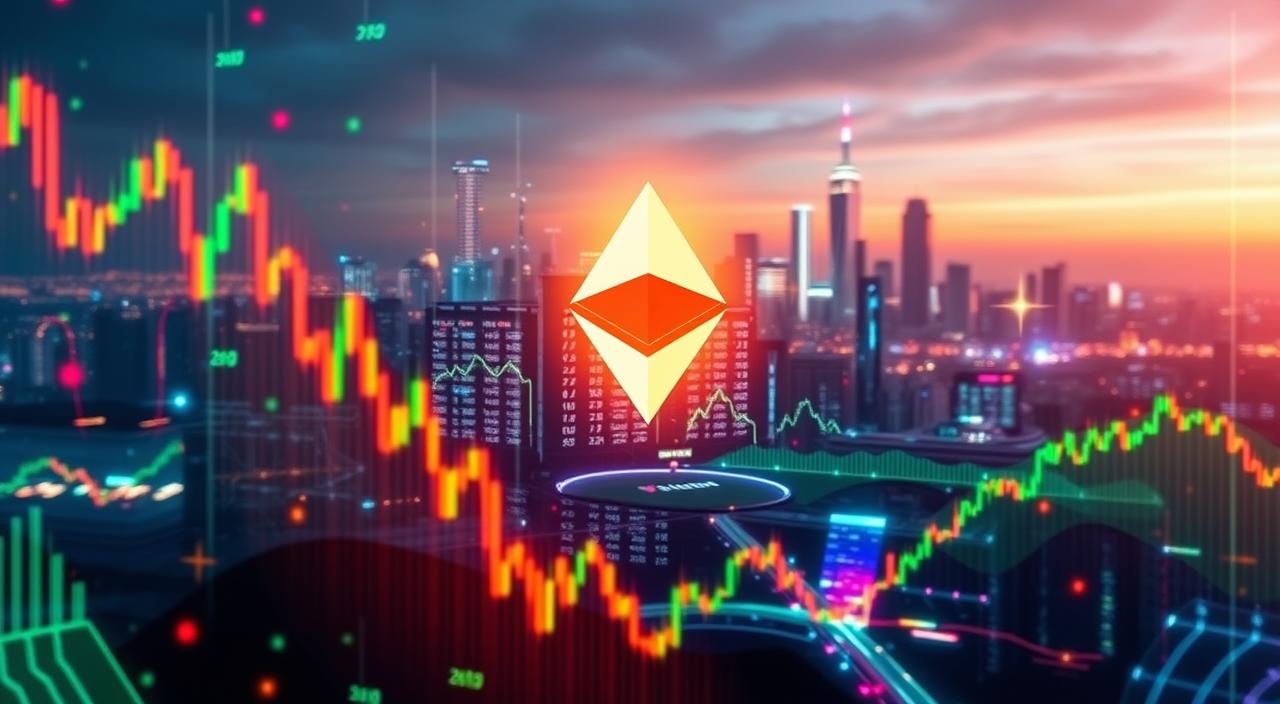Ethereum (ETH) is the second-largest cryptocurrency, launched in 2015 by Vitalik Buterin. It has changed the blockchain world with smart contracts, DeFi, and DApps. Ether (ETH) is key for transactions and smart contract use on Ethereum.
Key Takeaways
- Ethereum (ETH) is the second-largest cryptocurrency by market capitalization, with a focus on enabling decentralized applications and smart contracts.
- Ether (ETH) is the native token of the Ethereum network, used for powering transactions and smart contract interactions.
- Ethereum transitioned from Proof-of-Work (PoW) to Proof-of-Stake (PoS) with the Ethereum Merge in 2022, reducing energy consumption significantly.
- The Ethereum Shanghai upgrade allowed users to unstake previously locked ETH, boosting liquidity for stakers.
- Ethereum’s development roadmap includes scalability and performance enhancements through Phase 0 (Beacon Chain), Phase 1 (The Merge), and Phase 2 (Sharding).
Ethereum’s Core Utility and Ecosystem
Ethereum is the second-largest cryptocurrency and a key player in the digital world. It supports smart contracts, enabling developers to create many DApps. These apps work in finance, gaming, and supply chain management.
Decentralized Applications (DApps)
DApps on Ethereum run without a central authority. They offer a safe and open space for transactions and services. Ethereum’s blockchain powers these apps, bringing new solutions to the table.
Non-Fungible Tokens (NFTs) and DeFi
Ethereum is at the heart of the NFT market, making it easy to create and trade unique digital items. Its DeFi protocols, like DEXs and lending platforms, change how we deal with money.
Smart Contracts and Gas Fees
Smart contracts are the backbone of Ethereum. They make sure transactions are secure and efficient. Gas fees, paid in Ether, keep the network running by processing transactions and deploying smart contracts.
Ethereum’s vast ecosystem is vital for the decentralized internet. It supports new apps, unique digital assets, and changes in finance.
| Ethereum Ecosystem Metrics | Value |
|---|---|
| Decentralized Applications (DApps) | Over 3,000 |
| Non-Fungible Tokens (NFTs) | $25 billion in trading volume |
| Decentralized Finance (DeFi) | $54 billion in total value locked |
| Ethereum Gas Fees | Approximately $25 million per day |
“Ethereum has become the de facto platform for decentralized applications, providing a secure and transparent environment for developers to build innovative solutions that challenge traditional centralized models.”
Ethereum’s Pectra Upgrade
The Pectra upgrade is a big step for Ethereum. It makes the network better at handling accounts, validators, and data. This upgrade is key for Ethereum’s future growth and performance.
Account Abstraction
Account abstraction is a big part of the Pectra upgrade. It makes using Ethereum easier by simplifying wallet management. Users can now interact with the network more smoothly.
Validator Operations
The Pectra upgrade also makes validator operations better. It offers flexible staking and better efficiency. This means validators can help keep the network safe and stable more effectively.
Improved Data Handling
Pectra introduces Verkle trees for better data handling. These trees make storing and processing data more efficient. This upgrade boosts the network’s performance and scalability.
The Pectra upgrade shows Ethereum’s dedication to innovation. It prepares the network for future upgrades and milestones. By tackling key challenges, Pectra helps Ethereum reach its goals of better ethereum scalability, ethereum performance, and a better user experience for the ethereum ecosystem.
“Ethereum’s Pectra upgrade is a big step towards making the network better. It improves account handling, validator operations, and data management. These changes will make Ethereum stronger and more scalable.”
Ethereum’s Transition: From Proof-of-Work to Proof-of-Stake
In September 2022, Ethereum made a big change. It moved from Proof-of-Work (PoW) to Proof-of-Stake (PoS). This change, called the “Ethereum Merge,” has made Ethereum much more energy-friendly. Now, Ethereum uses less than 1% of the energy it used before.
With PoS, Ethereum’s security comes from validators who use their Ether (ETH) tokens. This is different from the old system where miners solved puzzles. The new system is better for the environment and more secure against attacks.
The Ethereum Merge is a big step for Ethereum. It’s making the network better for the future. Ethereum wants to be faster, cheaper, and more user-friendly. This will help it stay a top choice for apps, NFTs, and DeFi.
“The Ethereum Merge represents a significant step forward in the evolution of the Ethereum network, showing the team’s dedication to a greener and safer blockchain.”
Ethereum is moving towards Ethereum 2.0, and PoS is a key part of that. It’s making Ethereum more efficient and ready for the future. This change will help developers and users a lot.
The Ethereum Shanghai Upgrade
The Ethereum Shanghai upgrade is a big deal in the blockchain world. It came after the Ethereum Merge and lets users unlock their staked Ethereum (ETH) on the Beacon Chain.
Unstaking ETH from the Beacon Chain
The Ethereum Shanghai upgrade is a game-changer. Before, users couldn’t get their staked ETH back. Now, they can unlock their assets.
This change makes Ethereum staking more appealing. It’s no longer just for long-term investors. Now, more people can manage their Ethereum holdings better.
After the upgrade, Ethereum’s price jumped by 15% in a day. Trading volume also rose by 20%. This shows the community loves the upgrade.
“The Ethereum Shanghai Upgrade is a game-changer for the entire blockchain ecosystem. By unlocking staked ETH, it has ushered in a new era of flexibility and liquidity that will undoubtedly drive further adoption and innovation.”
The Ethereum Shanghai Upgrade marks a big step for Ethereum. It’s expected to impact not just Ethereum but the whole crypto and DeFi world.
Ethereum 2.0 Roadmap: What Comes Next?
The Ethereum network is on a big journey with its Ethereum 2.0 upgrade. This upgrade will make the blockchain better in many ways. It will be more scalable, secure, and sustainable. Let’s look at the main parts of the Ethereum 2.0 roadmap and what’s coming next.
Phase 0 (Beacon Chain)
Phase 0, or the Beacon Chain, started Ethereum 2.0. It brought a new way of agreeing on transactions called Proof-of-Stake (PoS). This is different from the old way, Proof-of-Work (PoW). The Beacon Chain lets users stake their Ether and help keep the network safe.
Phase 1 (The Merge)
Phase 1, called “The Merge,” was a big step for Ethereum. It merged the old Ethereum mainnet with the Beacon Chain. This made Ethereum more energy-efficient and better for the environment. It also set the stage for even more improvements.
Phase 2 (Sharding)
The last phase, Sharding, is expected between 2023 and 2024. It will split the Ethereum network into smaller parts called shards. Each shard can handle transactions at the same time. This will make Ethereum faster and more efficient for everyone.
The Ethereum 2.0 roadmap is a detailed plan to solve Ethereum’s scalability problems. It aims to keep Ethereum leading in DeFi and Web3. As we move through these phases, we’ll see a better Ethereum network. It will be faster, safer, and more ready for new applications and services.
| Phase | Key Developments | Timeline |
|---|---|---|
| Phase 0 (Beacon Chain) | Introduction of Proof-of-Stake consensus mechanism | 2020 |
| Phase 1 (The Merge) | Transition from Proof-of-Work to Proof-of-Stake | 2022 |
| Phase 2 (Sharding) | Partitioning of the network into multiple shards for improved scalability | 2023 – 2024 |
ethereum price
The Ethereum network is a key player in the digital world. It’s the second-largest cryptocurrency by market value. People watch its price and fees closely.
Transaction Fees and Gas Fees
Ethereum lets users send transactions, which cost gas fees. These fees are in ETH and help keep the network secure. The fees change based on how busy the network is and the transaction’s complexity.
Purchasing and Trading ETH on Exchanges
You can buy and trade Ethereum on places like Binance. The price of Ethereum (ETH) updates live on these sites. This helps investors make smart choices. Binance is easy to use and has many trading options.
| Cryptocurrency | Current Price | 24-Hour Change | Market Capitalization |
|---|---|---|---|
| Bitcoin (BTC) | $70,079 | +1.2% | $1.32 trillion |
| Ethereum (ETH) | $2,564 | +0.8% | $306 billion |
| Ripple (XRP) | $0.547 | -0.3% | $27 billion |
As Ethereum grows, knowing its price, fees, and trading options is key. It’s important for those in the digital asset world.
Conclusion
Ethereum has become a key blockchain platform. It supports many decentralized apps, non-fungible tokens, and new financial tools. Its recent updates and the Ethereum 2.0 roadmap are making it even better. This will help it stay at the top in the crypto and blockchain world.
The platform is very versatile. It helps create decentralized apps and grows the non-fungible token and decentralized finance sectors. The move to proof-of-stake and Ethereum 2.0 will make it even more user-friendly. This could lead to more people using it.
Ethereum is very important for several reasons. It can host smart contracts and support a lot of decentralized apps. It also makes transactions safe and clear. As the crypto and blockchain world keeps changing, Ethereum’s ability to innovate will be key to its success.
FAQ
What is Ethereum and how does it differ from Bitcoin?
Ethereum is the second-largest cryptocurrency, known for smart contracts and DeFi. It’s different from Bitcoin, which is mainly a digital currency. Ethereum is a platform for developers to build apps.
What are the key features and utilities of Ethereum?
Ethereum supports smart contracts for apps in finance, gaming, and more. It’s also the base for NFTs, DEXs, and DeFi. Users can trustlessly transact, paying gas fees in Ether.
What is the Ethereum Pectra Upgrade, and what are its key features?
The Ethereum Pectra Upgrade improves account abstraction and validator efficiency. It includes Account Abstraction, better staking, and Verkle trees for data storage.
How did Ethereum transition from Proof-of-Work to Proof-of-Stake, and what are the benefits?
Ethereum switched from PoW to PoS in September 2022. This cut energy use by over 99%. Now, validators stake ETH instead of miners solving puzzles.
What is the Ethereum Shanghai Upgrade, and how does it affect staking and liquidity?
The Ethereum Shanghai upgrade lets users unstake ETH. This makes staking more flexible and increases liquidity.
What is the Ethereum 2.0 roadmap, and what are the key phases?
Ethereum’s roadmap includes major upgrades for better performance. Phase 0 started the Beacon Chain. Phase 1, The Merge, completed the PoS shift. Phase 2, Sharding, will improve scalability by 2024.
How can I purchase and trade Ethereum (ETH)?
You can buy and trade Ether (ETH) on Binance. The current price of Ethereum is always up to date on Binance.

My name is Jakir, I am a content writer, content creator, I give business, sports, finance, trending news and I have 10 years of experience in this and this is my blog goldennews24.com.










